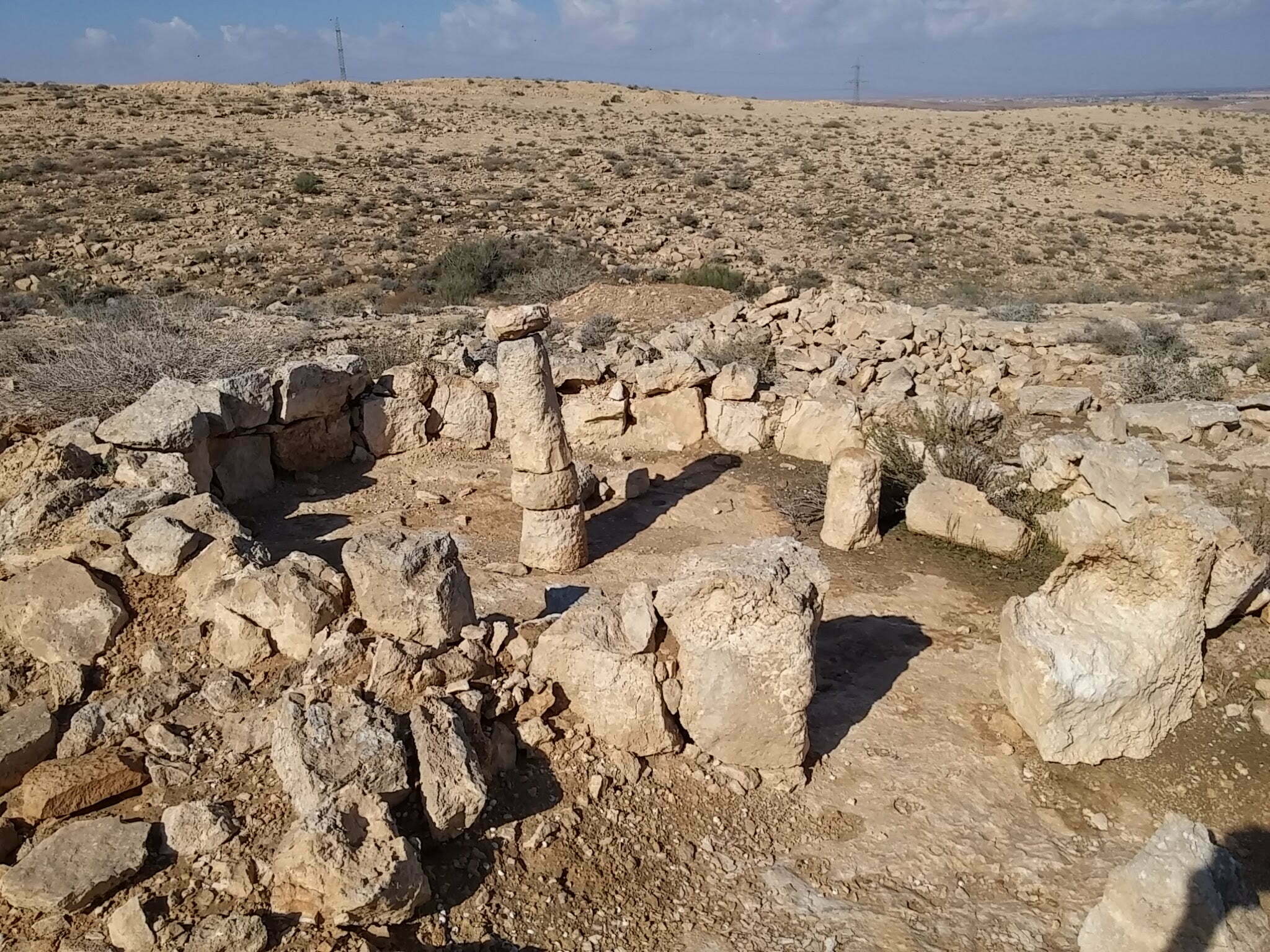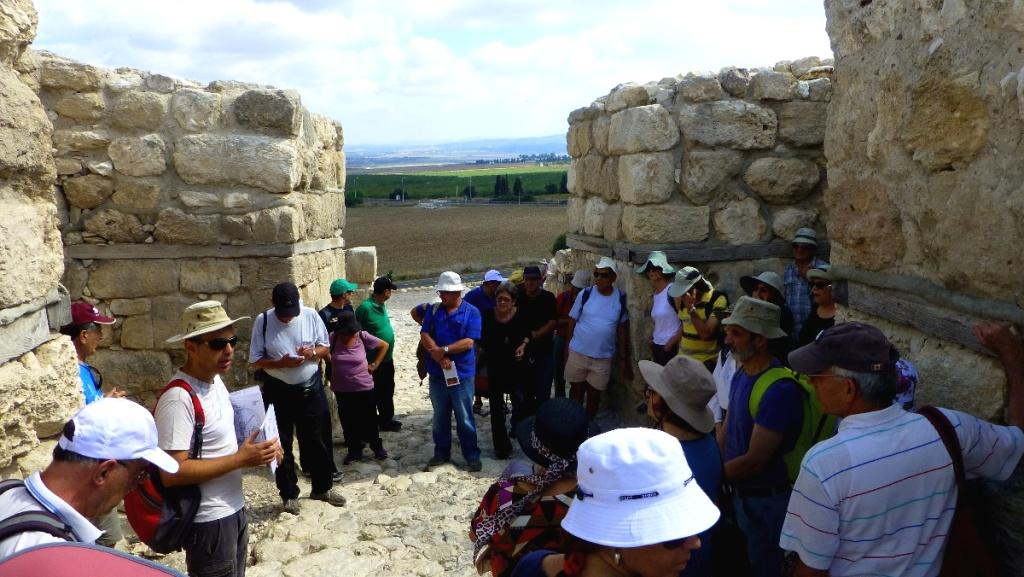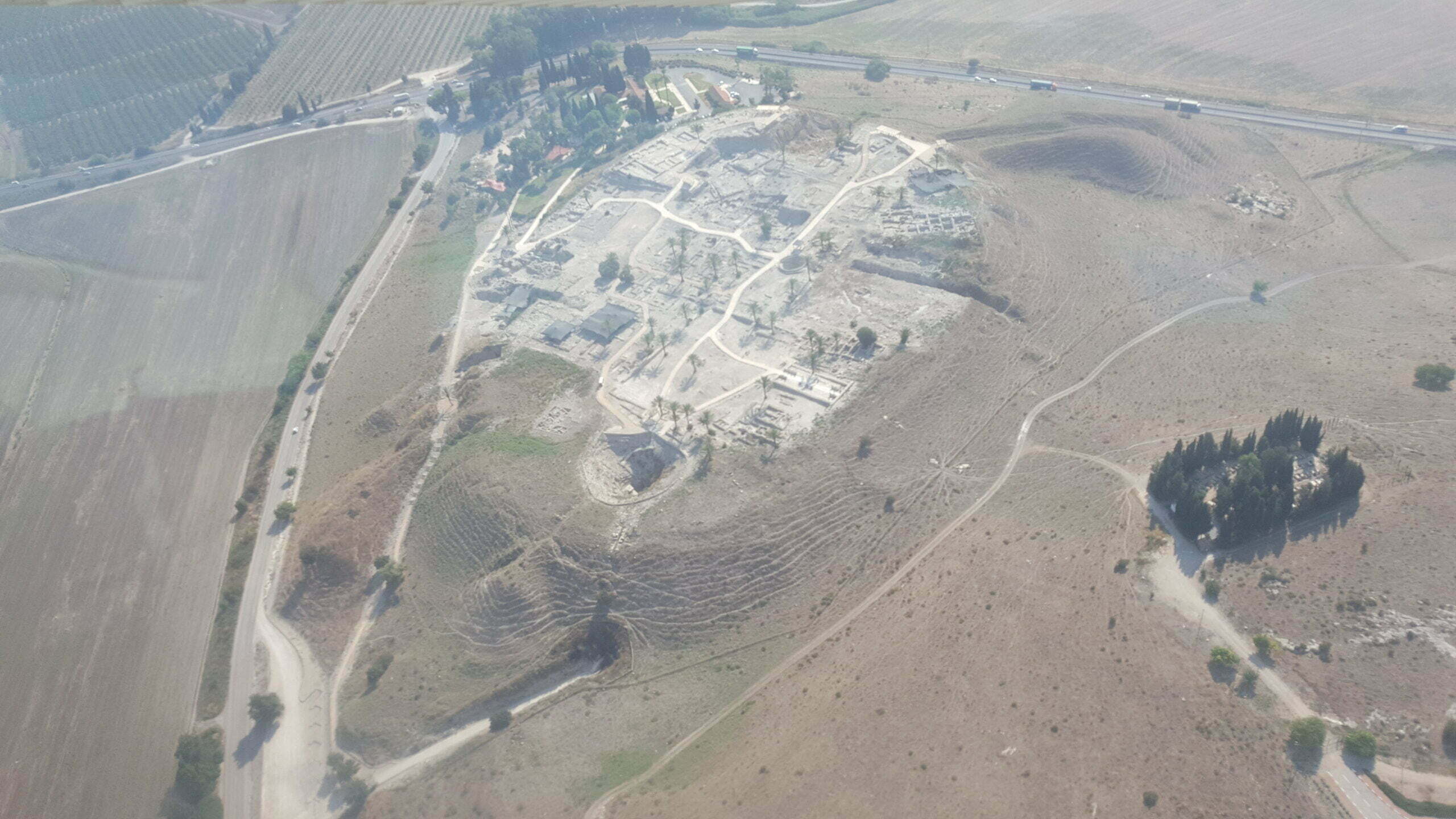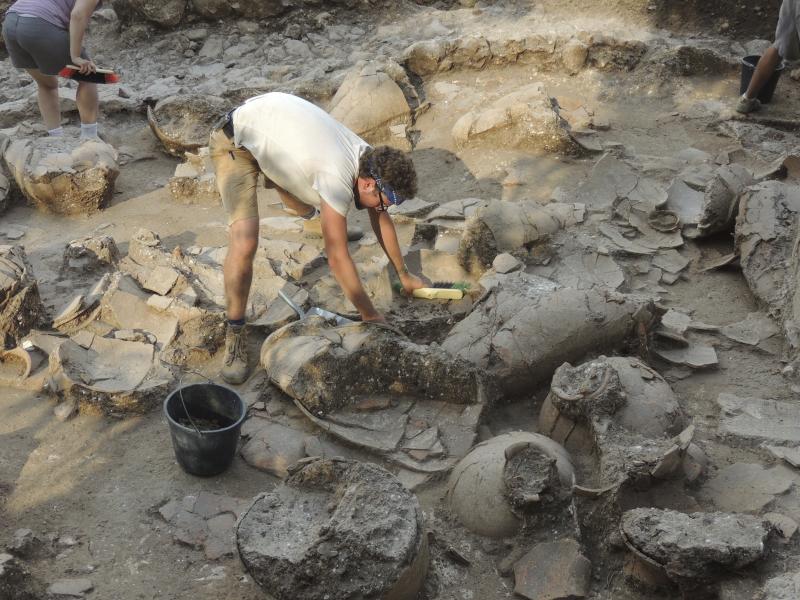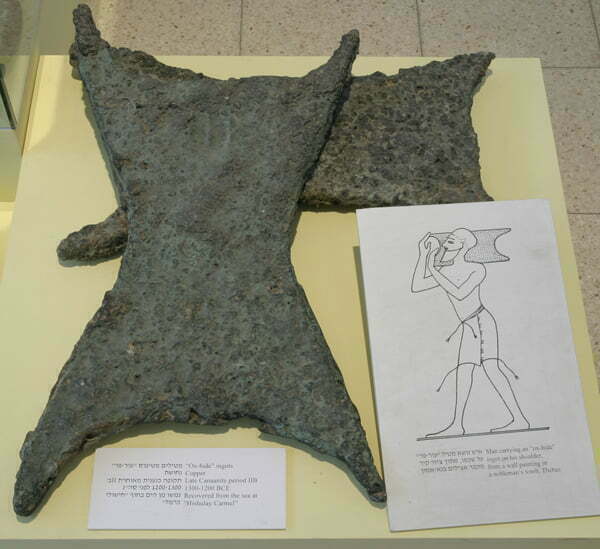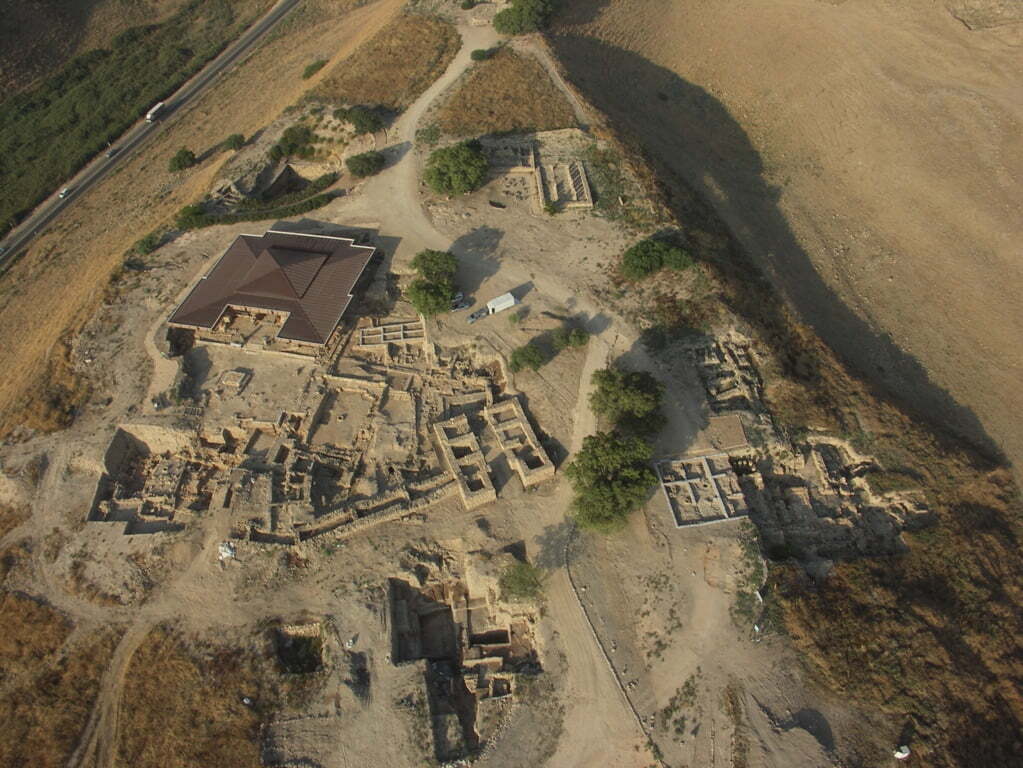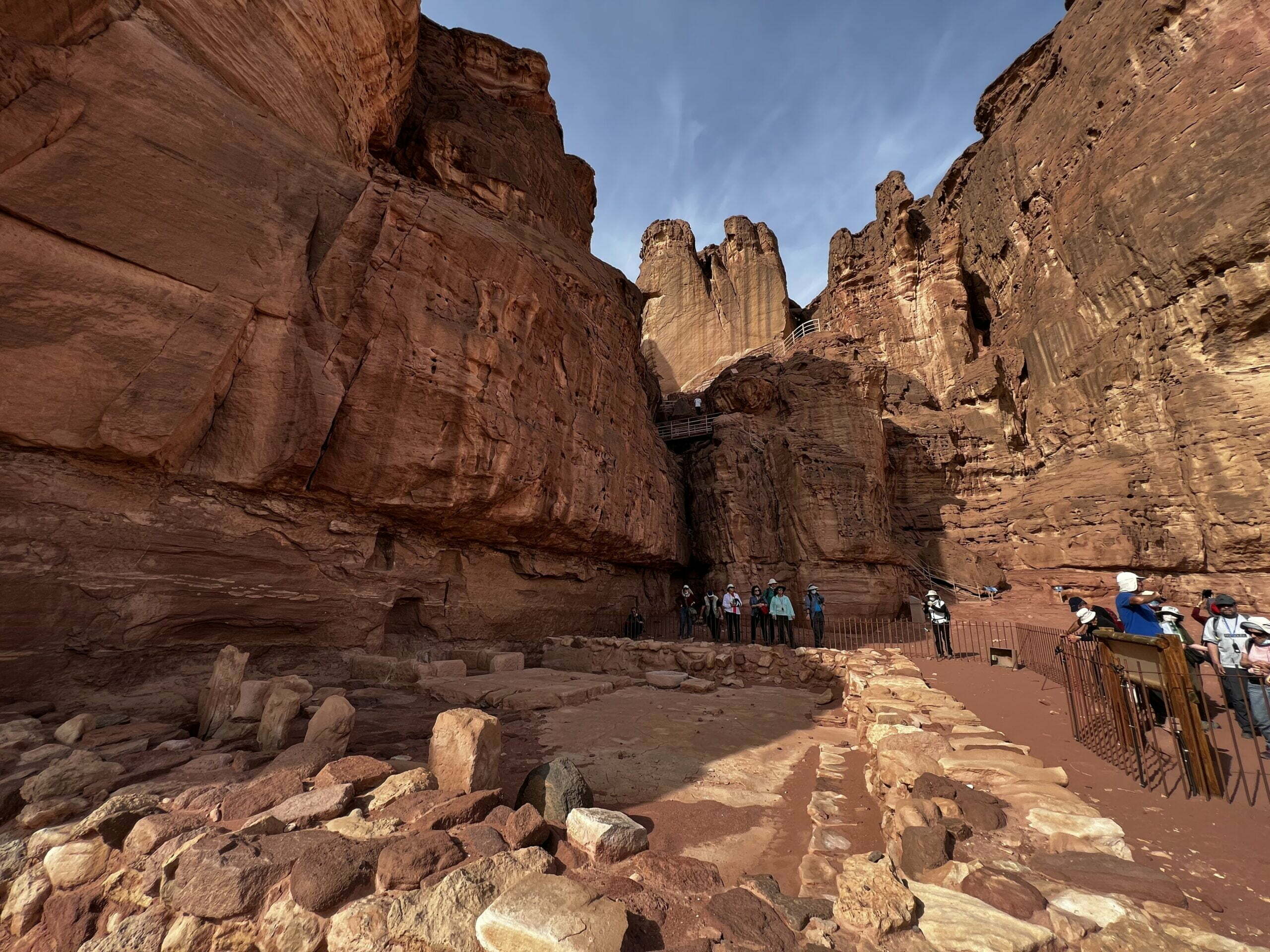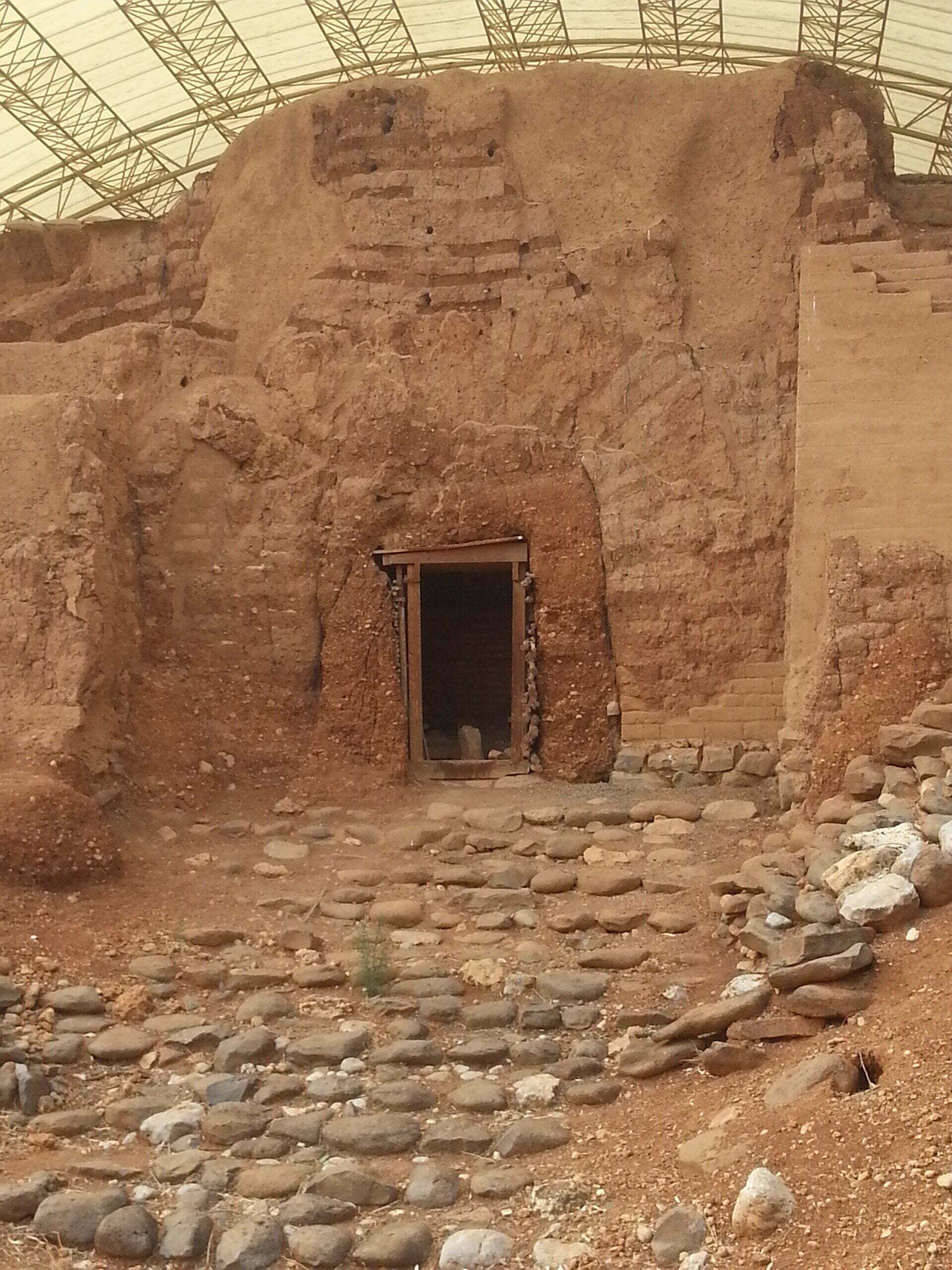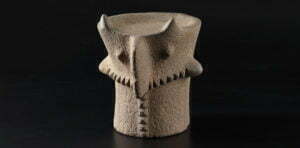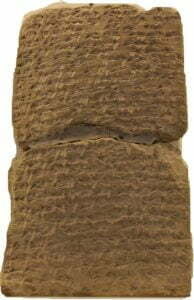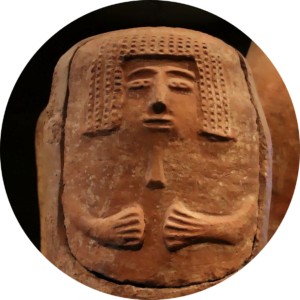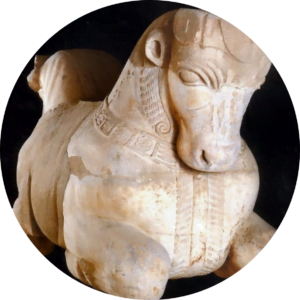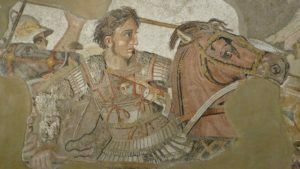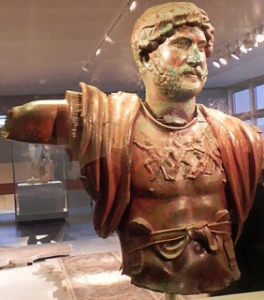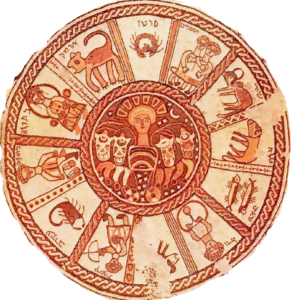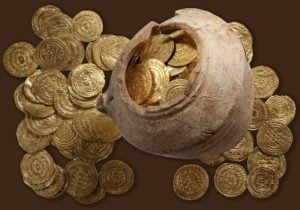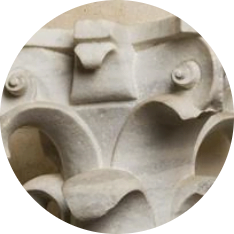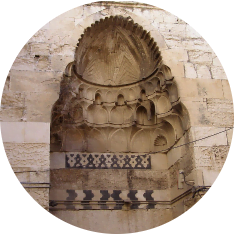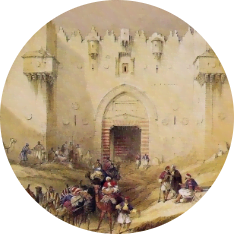The Bronze Age in the Land of Israel lasted about 2,500 years (from about 3700 to about 1200 BCE). The first part of the period is protohistoric[1], while from the second millennium, we also have historical evidence alongside the archaeological evidence. During this period, towns were first established in the country and the structure of the city states served as the main social format. There is also evidence of international ties with regional powers such as Egypt, Hatti, Mittani and Assyria, as well as with maritime cultures.
A recurring pattern during this period was the founding of settlements, followed by destruction and re-occupation. Over the course of thousands of years this pattern had a great impact on the landscape of the Land of Israel. Some of these sites have been systematically and thoroughly excavated (sometimes by various expeditions over the years) and form an important dataset for understanding the period and its various stages.
The Bronze Age in the Land of Israel is divided into four sub-periods: Early Bronze Age; Intermediate Bronze; Middle Bronze and Late Bronze. Each period has been internally divided into phases. Below we will briefly characterize the sub-periods.
[1] History begins in a country when there are texts that refer to the place. The term protohistory refers to a stage in which there are still no texts describing the Land of Israel, but in Egypt and Mesopotamia writing was already prevalent.
Early Bronze Age
The chronology of the Early Bronze Age in recent years has been based on absolute dating originating from carbon-14 testing in many sites throughout the Land of Israel. In light of this, the subdivision and chronology are as follows:
EB IA: 3700 – 3300 BCE
EB IB: 3300 – 3100
EB II: 3100 – 2900-2800
EB III: 2900-2800 – circa 2500
The spread of the settlement in the country focused on fertile areas such as the valleys, the Shephelah and the coastal plain. It is interesting to note that the villages of the beginning of the period were built without affinity and continuity relative to the settlements of the previous (Chalcolithic) period. Some of the rural settlements expanded and grew, covering areas of hundreds of dunams. It also appears that in some localities during the EB IB period, a lower city was built (e.g., at Tel Erani and Megiddo).
The development of the Land of Israel during this period was not separate from more extensive processes that took place in the ancient Near East during this period. In Mesopotamia, in the fourth millennium, the first cities were built by the Sumerians (the first city was Uruk, Erech of Gen 10:10; Ezra 4:9). Cuneiform script was invented in Sumer and was later adopted by other peoples and cultures in the area. Egypt was united and the ancient kingdom was established that ruled all of Egypt. The hieroglyphic script was invented there. Thus, the social changes that took place in the Land of Israel were also related to the changes and cultural developments of these two cultural centers.
Early Bronze Age IA (3700 – 3300)
This stage marks the beginning of the Early Bronze Age in the Land of Israel and is characterized by rural villages and a simple material culture, both in terms of technology and in terms of shapes and decorations. This sub-period is a transition between the end of the Chalcolithic culture and the culture of the Early Bronze Age. Thus, there are elements in the material culture whose origins can be found in the earlier period (e.g., pottery and olive cultivation as important components in the economy of the inhabitants). The livelihood of Early Bronze Age inhabitants was based more on agriculture, compared to the nomadic and pastoral element that characterized the inhabitants of the country in the Chalcolithic period. Settlements were built mainly in fertile agricultural areas. The findings indicate that the economy of the period was based on field crops, vineyards, olive cultivation and pasture, although on a relatively small scale.
There was no planning apparent in the settlements of the period, as the houses were very simple and had an elliptical layout (sometimes with auxiliary buildings alongside). Settlements consisted of clusters of houses with wide open areas between them. Pottery was either homemade, or produced in village workshops, so there is great diversity in the finds regarding the shapes of the vessels, the decorations and the level of expertise of the producers. In the ceramic finds one can also discern, in some cases, the continuity of traditions (especially in the shapes) of the vessels from the earlier period, alongside the emergence of new traditions (extensive use of ledge handles, red coating and sometimes also burnishing). Gray Burnished Ware is a unique group that was typical of the north and included only open bowls or basins in gray with a dense and shiny burnish. The sides of the bowls were angled and decorated with a row of lugs. These utensils were made by experts and some of the artistic traditions reflected in this category had roots in the northern Levant, so there may have been a northern influence or orientation of the potters of this period.
Early Bronze Age IB (3300 – 3100)
During The EB IB the villages in Canaan grew in area and density, but it was usually not apparent that there had been planning in the organization of the settlements and their public spaces. The material culture reflected the specialties of artisans and inter-regional trade in raw materials and luxury items can be discerned. This is reflected, for example, in large houses where finds were discovered that indicated greater wealth, as well as a temple quarter (Megiddo). At the beginning of the period, a process of establishing densely populated villages can be discerned. The findings indicate social stratification (this is also reinforced by the findings in some of the tombs), public buildings and the accumulation of considerable wealth, especially in the south of the country. In the later part of the period, a number of villages (mainly in the north of the country, such as Beit Yerach and Tel Assor) reached their peak and an indication of social hierarchy can be found. Fortifications were only erected in a few of the sites (Tel Shalem in the Beit She’an Valley and Ein Tzippori) – these represent the first appearance of this phenomenon that will become very common in the next stage (EBII). A compound with temples, strongly influenced by Egyptian culture, was discovered at Tel Megiddo, which was used, inter alia, to glorify power and rule.
Attention should be paid to a unique phenomenon of the presence of Egyptian colonies in southwestern Canaan. It has not yet clear whether the colonies were part of the central Egyptian government, or whether they were refugees who had settled in Canaan. There are also remaining questions concerning the essence of their ties with the locals; is this evidence of trade ties, or a forceful exploitation by an external occupier? The center of the Egyptian settlement was at Tel es-Sakan (today, in the Gaza Strip), but additional evidence was found at many sites, some with only an Egyptian presence (Ein HaBesor) and some at sites shared by Egyptians and Canaanites (Tel Halif).
The pottery industry of the period reflects regional styles and influences, but the distribution of the pottery indicates an array of interregional connections. The richness of the ceramic styles indicates connections and interactions, however trade ties and specialized markets were absent. Familiarity with Mesopotamian traditions and culture was reflected in decorations that used stamps on pottery (in the western Jezreel Valley), but unlike in Mesopotamia, in the Land of Israel stamp impressions had no administrative significance – they were only decorative.
At the end of the period, some of the settlements (such as Megiddo and Beit She’an) were abandoned. Localities that were settled in the next period were rebuilt under a different layout. The Egyptian presence in the south of the country also dissipated and this may be one of the reasons for the change and the end of the period. Other explanations relate to internal power struggles within Canaanite society.
Early Bronze Age II (3100 – 2900-2800)
This period is of great importance, as it is when the process of urbanization can be identified. In the towns of the period, as well as fortifications, the specialization and professionalization of artisans in cross-regional economic systems can be recognized. The community expanded and united a number of families. At the same time, towns in the Land of Israel were not run in the same manner as towns in Syria and Mesopotamia, where managers were installed. However, the Canaanite towns formed the basis of a social structure that existed in the land for nearly 2,000 years.
In terms of material culture, the country can be divided into the following three areas: The northern area includes the Golan Heights, the Galilee, the Jezreel Valley and the Jordan Rift Valley, with sites such as Tel Dan, Kiryat Ata, Tel Beit Yerach and the Lavia compound; the central area includes sites such as Tel el-Farah (North), Ai and Tel Dalit; Arad was the main site in the southern region.
During this period, Canaanite objects were found in Egypt in the clear context of the kings of the First Dynasty. Egyptian objects were also found in the Land of Israel. These findings along with absolute dating of organic matter from various sites in the country are the basis for dating the period.
At the beginning of the period, the Egyptian settlements were abandoned and some of the sites were not taken over by locals. Many settlements in areas such as the Shephelah and the valleys were built on hills and fortified. In areas, which were not inhabited in the previous period, such as the Golan Heights and the Hula Valley, new settlements were built. For the most part, even small sites were fortified during this period. There is evidence of a unique phenomenon in the Negev, where permanent settlements were established. These inhabitants engaged in agriculture and they had clear ties to Arad. There is also evidence of a connection between Arad and the localities of the period in southern Sinai. Apart from fortifications, in some of the localities, urban planning can be discerned. Public buildings were constructed. In Arad, for example, temples, palaces and a waterworks have been discovered, but such buildings were not common at other sites of the period. Arad, unlike other localities of the period, stands out as a production center and had an important and central role in trade.
Early Bronze Age III (2900-2800 – 2500)
One of the essential differences between this period and its predecessor was the development of a multi-class society with considerable differences between the classes. Many settlements were abandoned and the population was concentrated in the towns during this period. Commercial ties were few and far between. The fortifications of the period were very impressive and they mainly reflected the capacity for public construction (since technologically, there were no weapons that justified such mighty fortifications). The fortifications of the period were not uniform, and in every urban center emphasis was placed on different characteristics. Other public buildings were common during the period, one of the most prominent of which was the palace discovered at Tel Yarmout in the Lowland. But this was not the only feature of urban culture at Tel Yarmout. Next to the palace neighborhoods were built that reflected the social classes including: A section of affluent homes that were situated west of the palace and a section of crowded dwellings north of it. The palace at Tel Yarmout was built according to set dimensions (cubit = 52 cm) and on the basis of careful planning and strict adherence to the quality of construction (right angles, trimmed items, quality of flooring, etc.).
Temples and worship complexes have been identified at several sites (Horvat a-Zircon, Megiddo, and Ai). These buildings had no significant ritual findings and were built in a prominent location in the settlement which differed from the other buildings. It should be noted that there was no connection between the buildings of the palaces, the houses of the elite and the temples. Moreover, unlike the practice in the temples of Mesopotamia, it does not appear that the temples of Canaan served as economic centers.
The absence of elite tombs raises the possibility that there was an ideology of equality in Canaan that originated in the period of EBII. It is possible that even during this period, despite the inequality seen in the settlements, that this tradition continued to exist in the burial of the dead.
At the beginning of the period, there is evidence of the existence of a foreign population in the area of the northern valleys. This population was present in existing settlements alongside the local Canaanite population as well as in localities that had already been abandoned by their Canaanite inhabitants. In the past, the population was identified mainly by “Beit Yerach” type of pottery (named after the site where it was first identified), but today we identify other characteristics, such as the use of mud and clay for construction and flooring, flint tools, bull-shaped figurines and more. These traditions are known from sites in southeast Anatolia, north Iran and south Caucasus. The current appellation for this group is the Kura-Araxes Cultural Community. The origin of this population seems to be from the south Caucasus.
The urban centers of the period were thus characterized by fortified settlements on prominent tels. The rulers were wealthy and powerful, while the population was relatively small with only a loose affinity for the city, manifested in joint ceremonies and construction works. The ability of the rulers to manage economic resources and relations with the rulers and other localities (along with other groups such as nomads), is paramount for understanding the nature of the culture of the period and the circumstances of its demise. That is, when a particular city had many enemies (neighboring towns, nomads and perhaps, even some of the town’s residents) the end of that settlement was near.
From the middle of the third millennium, changes took place in Syria, in the wake of the development of the textile industry, which required large herds and pastures. These developments accelerated socio-economic changes in the Land of Israel, from an economy of urban centers to an economy based on herding and rural agriculture. Some scholars have attributed the end of the period to the collapse of the urban system. According to them, changes such as population growth, climate change or external (Egyptian) intervention were the factors that led to the collapse of the settlement-social system in Canaan. It is possible that this combination of causes and circumstances were the ones that led to the end of the Early Bronze Age.
Intermediate Bronze Age[2] (2500 – 2000)
[2] Due to being a transitional period that continued elements of Early Bronze Age culture and renewed cultural elements that became common in the Middle Bronze Age, some scholars call this period “Early Bronze IV” while American archaeologist William Foxwell Albright, who established, in the first half of the 20th, the chronology of the historical periods in the Land of Israel, called the period “Middle Bronze I”.
As its name implies, the period is situated between two urban periods and is indeed a transition period distinguished by a culture different from the Early Bronze on the one hand and the Middle Bronze on the other. The Intermediate Bronze Age is characterized by rural settlements (usually sites that were not previously inhabited and did not continue into the next period), with some localities established in peripheral areas (such as the Jordan Rift Valley, the Negev Highlands and Sinai).
Although settlements also existed at multi-period sites (such as Dan, Hatzor and Megiddo), the construction there was not monumental and even at tel sites settlement was rural and small. The settlements of the period were not fortified, the exception being Khirbet al-Mayita, in northeastern Samaria, where a fortification was discovered, which surrounded the settlement that existed only during this period. As mentioned, in the Negev Highlands, settlements were established at new sites, and in Sinai, settlements developed in the north and center, not in areas where there had been settlements in the Early Bronze Age. The Negev Highlands settlements included both permanent settlements and temporary sites. Copper ingots were found in settlements in the Yeruham area. The fact that no sheep pens, or sickle blades were discovered at these sites raises the likelihood that their inhabitants were engaged in working the metal and trading in it and not in agriculture.
The most common tombs of the period were shaft tombs and adjacent to them were also found interment in natural caves, under timuli and dolmens. The burial was usually of a single or a small number of individuals, usually as a secondary burial. The cemeteries of the period were widespread and some hundreds of tombs have been discovered.
The pottery of the period was divided into many categories (mainly by geographical division). Continuity of the traditions of the previous period can be discerned alongside innovations in pottery shapes, decorations and technology.
The analysis of the distribution of the settlements and the findings of the period shows that the economy in the south of the country and in Sinai was based on copper production and trade. In the more northern and humid regions the economy was based on agriculture and grazing with the household comprising the base unit.
Middle Bronze Age (2000 – 1500)
This period is divided into three sub-periods (Middle Bronze I, II, and III). During this period, urban settlement in the Land of Israel was renewed, and for the first time, a multi-layered and complex society was evident in many localities.
The period begins in the second half of the 20th century. A little later there are findings that indicate ties with Egypt. The early phase (Middle Bronze I) dates to about 1950-1710. The transition to the next stage is generally attributed to the middle of the 13th Dynasty in Egypt and Middle Bronze II continued to the 15th Dynasty (Hyksos). The transition between sub-periods is characterized by continuity and is marked by synchronization with Egypt, especially to the Nile Delta region. Middle Bronze III is usually dated to 1590-1470. The end of the period was determined, among other things, by historical contexts such as the expulsion of the Hyksos from the Delta and the establishment of the New Kingdom in Egypt. A groundbreaking event marking the transition between the periods was the conquest of the city of Sharuhen, one of the last strongholds of the Hyksos, in southern Canaan, by Ahmose. However, the transition between archeological periods is not measured by a single historical event and it occurred at different places at different times. Therefore, the end of this transition was marked by the campaigns of Thutmose III.
Urbanization, characterized by a multi-layered and complex society, in this period began in the middle of Middle Bronze I. Settlements such as Megiddo and Afek became fortified. This process led to the creation of a hierarchy of an urban center with surrounding towns and villages. Urbanization first took place in the coastal plain and in the valleys and with urban centers in the central mountain region. It arrived at Shechem and Jerusalem only in Middle Bronze II. The center established in Hatzor was exceptional in its status. The next urban centers in the hierarchy were settlements such as Ashkelon and Kabri. The big towns had regional economic centers, a large population, fortifications, public buildings and social stratification. An important characteristic of Middle Bronze Age towns was the surrounding fortifications and an array of gates. The fortifications of the period comprised a number of elements such as, walls, embankments, moat, towers and gatehouses that functioned as independent forts. Many of these mighty fortifications have shaped the shape of the tel to this day, for example in Kabri, Ashkelon, Tel Miqne-Ekron and more. These impressive fortifications, and especially the huge earthen embankments, were apparently intended not only for the protection of the towns, but also to allow the rulers of the towns to demonstrate their power both towards their own people and towards their rivals.
One of the important social institutions of the period was the town palace. Palace buildings were discovered at many sites, such as, Kabri, Tel Ifshar, Tel Afek, Megiddo and Lachish. It seems that some of the activity that took place in the palaces were related to revelrys and lavish banquets designed to serve the political needs of the elites.
The temples of the period attest to the continuity of traditions from the previous period, such as the use of stone monuments, along with the advent of influences, mainly from Syria. These included the “Syrian” type temple, also known as the tower temple, which should be linked to the new elites established at this period.
The tombs of the period also include the tradition of burial outside the town, alongside a new tradition of burial within the town, both in constructed tombs and the burial of children and infants in jars.
Cultural influences are reflected in this period in the technology of pottery production and the metal industry. The pottery of the period was characterized by high quality and the use of high-speed wheels. Many vessels were decorated, commonly with a polished red coating. There were also other decorations, such as the Tel el-Yehudiyeh style, named after a site in the Delta in Egypt, where ware of this type was first found. However, production of these vessels was mainly in the Land of Israel; in the Jezreel Valley, western Galilee, the Shephelah, western Negev and also in Lebanon and Egypt.
During this period, trade relations existed on land, along the coast of the Land of Israel and at sea. The imported objects unearthed at various sites of the period indicate maritime trade connections, mainly with Cyprus but also with the Aegean. The imported ware was mostly dated to Middle Bronze II-III and included mostly closed and small pottery vessels. Alongside this, there was also a trade in organic materials (which were not preserved), as evidenced by historical documents of the period, mainly Egyptian, which describe trade in wood and aromatic oils.
Written findings and indications of writing in the country itself are very few. Writing was apparently not common in Canaan in the Middle Bronze Age, despite the complexity and stratification of society, the impact of internal and international trade and foreign influences on the material culture of the Land of Israel. This is especially noticeable against the background of the prevalence of the use of writing in Syria, Mesopotamia and Egypt.
The end of the Late Bronze Age was defined on the basis of historical changes – the expulsion of the Hyksos Dynasty and the beginning of the New Kingdom in Egypt. Along with the continuity of the traditions and material culture in the Land of Israel, there was a decline in the settlement framework and some of the main sites of the Middle Bronze Age were abandoned, or diminished in importance, for example, Kabri and Shiloh. It should be noted that the end of the Middle Bronze Age should not be attributed to one Egyptian campaign or another and it seems to have been a long process that lasted for decades.
Late Bronze Age (1500 – 1150)
It is customary to divide the period into three main stages: Late Bronze Age I (1500-1400), Late Bronze Age IIA (1400- 1300), Late Bronze Age IIB (1300-1200).
The beginning of the period is related to the expulsion of the Hyksos Dynasty from Egypt and the conquest of Canaan by Egypt. The process lasted for decades and was accompanied by the destruction of sites and the undermining of the geopolitical framework of the Canaanite towns of the Middle Bronze Age.
Researchers continues to debate the definition of the mid-12th century. Some consider these years as part of Iron Age I, while others define them as Late Bronze Age III. The differences in attitudes stem from the question of what defines the end of the period. If it is the fall of empires and the cessation of international trade, which characterized the Late Bronze Age – then the 12th century is part of the Iron Age. Alternatively, if it defined by the continuity in material culture, settlement distribution, social structure and continued Egyptian presence in the Land of Israel – therefore, these years should be called Late Bronze Age III.
International trade in the eastern basin of the Mediterranean peaked in the Late Bronze Age. The Land of Israel and its inhabitants took an active part in the mercantile activity. Evidence of this has been found in diplomatic archives, such as the El Amarna letters found in Egypt and at the Uluburun and Cape Gelidonya shipwrecks, discovered off the southern coast of Turkey. Further evidence was uncovered at many small and large archeological sites in the Land of Israel and from the entire eastern basin of the Mediterranean. Alongside permanent resident societies and nomads, there were displaced population groups, known as Habiru in contemporary texts, who lived on the margins of society.
This period has much historical written evidence. The origin of most of these texts is Egypt, which ruled the Land of Israel during the New Kingdom. Egypt’s rule in Canaan continued throughout the period, with changes in the nature and level of control. Yet the Canaanite identity of the inhabitants of the land was preserved throughout the period. The sources relating to the beginning of the period (Late Bronze I) refer mainly to the military campaigns of the kings of Egypt to our region. The most famous record is the description, which appears on the walls of the Temple of Amun in Karnak, modern-day Luxor, of Thutmose III’s campaign at Megiddo against the Kingdom of Mitanni and the coalition of Canaanite city states. The Karnak relief shows a list of 119 Canaanite city states spread from Gaza in the south to Kadesh, in Syria in the north, which surrendered to the king of Egypt. One of the results of the campaign was that the kings of Egypt began to appoint the rulers of the Canaanite city states with the sons of the rulers being educated in Egypt.
The historical information about the next stage (Late Bronze IIA) comes mainly from the Egyptian diplomatic archive discovered at El Amarna. Amenhotep IV led a religious revolution in Egypt in which Aten was proclaimed the chief Egyptian deity. As part of the revolution, he changed his name to Akahenaten and also established a new capital city, Amun was, known in Arabic as Amarna. His successor, Tutankhamun restored the old religious order, meaning that Amun was restored as the chief deity and Thebes was reestablished as the capital city. Part of the royal archive that was transferred to the capital city, founded by Akahenaten, remained in Amarna and was discovered about 150 years ago. The archive included about 350 letters written in cuneiform script in Akkadian, which was the international diplomatic language at the time. Most of the letters were sent to the king of Egypt from the rulers of the Canaanite city states. Through these letters, we are exposed to the strife and alliances among the various city states in Canaan. For example, some of these letters describe the rivalry between the rulers of Jerusalem and Shechem in the central mountain region. Many letters mention the Habiru outsider groups, which threatened the order in the country’s towns. Many others attest to the dependence of local rulers on Egyptian rule. From the letters one can learn about the ethnic groups that lived in the country, according to the names of those mentioned.
Egypt’s main rival during Late Bronze Age IIB was the Hittite Empire. Their struggle climaxed at the Battle of Kadesh in Syria, which took place in the days of Ramesses II. The transition to Late Bronze Age III is characterized by a crisis that occurred in the eastern basin of the Mediterranean. This crisis is reflected in the collapse of important kingdoms and cultures, such as the Mycenaeans in Greece, the Hittite Empire and Alashiya in Cyprus. During the 19th and 20th Dynasties, the Egyptians tightened their control and presence in the land. This was reflected, among other things, by construction in Egyptian government centers such as Beit She’an, where government buildings, Egyptian steles and evidence of Egyptian administrative presence were discovered. Structures with typical Egyptian layout, known as edifices of the Egyptian governor, were also discovered at sites in the south of the country, for example: Tel al-Farah (South), Tel Hesi, Tel Gama, Gezer and Afek. These structures have Egyptian finds as well as evidence of Egyptian administration.
The end of the Late Bronze Age was accompanied by dwindling and abandonment of settlements. One of the areas where this stood out was the central mountain region. On the other hand, there were cities which maintained continuity – the best example was Hatzor, the largest and most important city in the Land of Israel in the second millennium. An echo of this, appears in the Bible, Joshua 11:10: “And Joshua turned back at that time and captured Hatzor and struck its king with the sword, for Hatzor formerly was the head of all those kingdoms.” Settlement recovery in Canaan became evident in the 13th-12th centuries, probably due to the tightening of Egyptian rule in the country.
During the Bronze Age the country was divided between city states which ruled over small rural areas and there was therefore no need to develop complex administrative systems. The material culture discovered in the cities of the period included; palaces, affluent houses , temples rich in ritual objects, many imports originating in Cyprus and the Aegean region and luxury artefacts, including: ivory, faience ware, metal ware and jewelry. During this period no fortifications were built for the cities, in only a few of them did fortifications, built in the Middle Bronze Age, continue to be used. However, one of the important public buildings of the period was the city gate, which was discovered in various cities, such as Megiddo and Hatzor. The designs of the temples of the period were varied and less homogeneous than in the Middle Bronze Age. This may be related to the diverse cultural influences during this period and to international trade relations. Thus, temples with a Syrian temple design can be found, for example at Hatzor, Shechem and Megiddo and temples with an elevated sanctuary, as in Beit She’an and Lachish (the acropolis temple). Another type is the cultic enclosure, which is centered on a rounded stele as discovered in Tel Burna and, of course, temples with various layouts, such as the moated temple in Lachish, and the temple in Tel Mevorach. In the context of cultic sites, it is worth noting the widespread findings of pottery figurines depicting naked women.
The diverse population of the period can also be learned from burial customs, including interment in caves, pit tombs and burials within the city, continuing the rituals from earlier periods and alongside, at random, foreign burial customs, for example, niche tombs, constructed tombs and burial in jars.
On the turbulent transition between the Bronze Age and the Iron Age – see the overview of the Iron Age.
